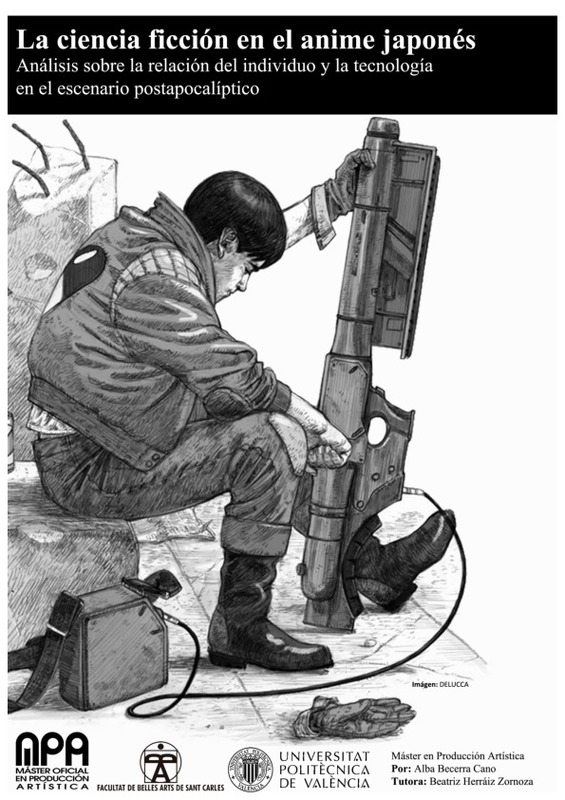JavaScript is disabled for your browser. Some features of this site may not work without it.
Buscar en RiuNet
Listar
Mi cuenta
Estadísticas
Ayuda RiuNet
Admin. UPV
La ciencia ficción en el anime japonés: análisis sobre la relación del individuo y la tecnología en el escenario postapocalíptico
Mostrar el registro sencillo del ítem
Ficheros en el ítem
| dc.contributor.advisor | Herráiz Zornoza, Beatriz
|
es_ES |
| dc.contributor.author | Becerra Cano, Alba
|
es_ES |
| dc.date.accessioned | 2016-02-15T11:01:37Z | |
| dc.date.available | 2016-02-15T11:01:37Z | |
| dc.date.created | 2015-07 | |
| dc.date.issued | 2016-02-15 | |
| dc.identifier.uri | http://hdl.handle.net/10251/60866 | |
| dc.description.abstract | [EN] This paper is based on surmised conjectures which attempt to understand Japanese society through its animated cinema and other potential representations. Through this collective imagination various issues, which relate to both past stigmas and to new paradigms created by technology, are outlined, as is the position of the individual in such settings. In Akira (1988, Katsuhiro Otomo) this question is immediately addressed: a hypothetical third World War which has left the world devastated by nuclear arms; the construction of a new city, Neo-‐Tokyo; and how the individual who finds himself in this setting tests the limits of his identity through the relationship between technology and science. Neon Genesis Evangelion (Shin Seiki Evangerion; Hideaki Anno, 1995) and Ghost in the Shell (Kōkaku Kidōtai, 1991, Masamune Shirow), without departing from the dystopian setting, bring the idea of an individual living in a future when machines are diluting the concept of the human being to the fore, where natural limits are disappearing and the question of artificial or spiritual existence, and more generally transhumanism, is put under the spotlight. To effectively explore the above ideas it is necessary to consider some more recent productions, such as Paprika (Papurika; 2006, Satoshi Kon) and various television series from the world of cyberpunk, in which technology is seen as a threat, above all by the most traditional and conservative parts of society. This is of particular interest given that Japan, despite being one of the most industrially advanced societies on Earth, is still governed by traditional values and that social ethics continue to be of profound importance to the contemporary view of society. | es_ES |
| dc.description.abstract | [ES] Este ensayo está basado en conjeturas aproximadas que intentan entender la sociedad japonesa a través del cine de animación y sus posibilidades de representación. A través de este imaginario audiovisual se esbozan diferentes problemáticas relacionadas tanto con estigmas del pasado como con los nuevos paradigmas que la tecnología plantea, así como el lugar que ocupa el individuo frente a este tipo de escenarios. Con Akira (1988, Katsuhiro Otomo) entramos de lleno en estas cuestiones; una supuesta III Guerra Mundial, un mundo devastado por las armas nucleares, la construcción de una nueva ciudad, Neo-‐Tokio, y cómo el propio individuo envuelto en este ambiente experimenta los límites de su propia identidad a través de la relación con la tecnología y la ciencia. Neon Genesis Evangelion (Shin Seiki Evangerion; Hideaki Anno, 1995) y Ghost in the Shell (Kōkaku Kidōtai;, 1991, Masamune Shirow), sin dejar atrás el escenario distópico, ponen sobre la mesa al individuo en un futuro en el que la machina diluye el concepto de ser humano, donde los límites naturales desaparecen y entra en juego la corporalidad artificial o espiritual, lo transhumano. Por último y para cerrar este compendio de ideas es necesario nombrar producciones más actuales como Paprika (Papurika; 2006, Satoshi Kon) y series relacionadas con la temática cyberpunk, donde lo tecnológico es visto como algo dañino sobretodo por las partes más tradicionales y conservadoras de la sociedad, ya que Japón a pesar de ser una de las sociedades más avanzadas industrialmente del mundo se sigue rigiendo por patrones tradicionales de comportamiento y la ética social sigue teniendo un profundo significado en el panorama contemporáneo. | es_ES |
| dc.format.extent | 86 | es_ES |
| dc.language | Español | es_ES |
| dc.publisher | Universitat Politècnica de València | es_ES |
| dc.rights | Reserva de todos los derechos | es_ES |
| dc.subject | Ghost in the Shell | es_ES |
| dc.subject | Akira | es_ES |
| dc.subject | ciudades distópicas | es_ES |
| dc.subject | cuerpo | es_ES |
| dc.subject | cyberpunk | es_ES |
| dc.subject | transhumano | es_ES |
| dc.subject | miedo | es_ES |
| dc.subject | guerra mundial | es_ES |
| dc.subject | ciencia-ficción | es_ES |
| dc.subject | sociedad japonesa | es_ES |
| dc.subject | Japón | es_ES |
| dc.subject | Anime | es_ES |
| dc.subject.classification | COMUNICACION AUDIOVISUAL Y PUBLICIDAD | es_ES |
| dc.subject.other | Máster Universitario en Producción Artística-Màster Universitari en Producció Artística | es_ES |
| dc.title | La ciencia ficción en el anime japonés: análisis sobre la relación del individuo y la tecnología en el escenario postapocalíptico | es_ES |
| dc.type | Tesis de máster | es_ES |
| dc.rights.accessRights | Abierto | es_ES |
| dc.contributor.affiliation | Universitat Politècnica de València. Escuela Politécnica Superior de Gandia - Escola Politècnica Superior de Gandia | es_ES |
| dc.contributor.affiliation | Universitat Politècnica de València. Departamento de Comunicación Audiovisual, Documentación e Historia del Arte - Departament de Comunicació Audiovisual, Documentació i Història de l'Art | es_ES |
| dc.description.bibliographicCitation | Becerra Cano, A. (2015). La ciencia ficción en el anime japonés: análisis sobre la relación del individuo y la tecnología en el escenario postapocalíptico. http://hdl.handle.net/10251/60866. | es_ES |
| dc.description.accrualMethod | Archivo delegado | es_ES |
Este ítem aparece en la(s) siguiente(s) colección(ones)
-
BBAA - Trabajos académicos [5086]
Facultad de Bellas Artes






